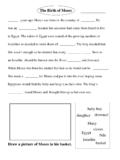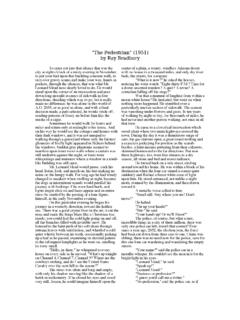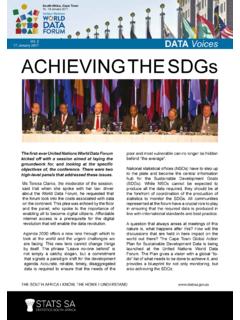Transcription of The Sponge ACCOUNTing System Verna C. Gibbs M.D. …
1 The Sponge ACCOUNTing System Verna C. Gibbs NoThing left behind . The Sponge ACCOUNTing System is a multistakeholder, manual surgical Sponge management practice designed to eliminate the problem of retained surgical sponges . It is a standardized, transparent, simple and inexpensive practice that incorporates defined structural and behavioral elements for OR and procedural area personnel. The structural elements require plastic hanging Sponge holders, standard issue radiopaque surgical sponges and a mounted dry erase board in each OR. Behavioral change requires nurses to use a standardized process to load the Sponge holders and document the Sponge counts on the dry erase board.
2 Surgeons must perform a methodical wound exam in every case and verify with the nurses at the end of the case that all sponges are in the holders before leaving the OR. Radiologists are called when there is a missing Sponge to ensure that high quality xray images are obtained and to provide expert x-ray image interpretation. The System provides standardized practices and addresses communication problems which are the root causes of why retained surgical sponges occur. Current Sponge management practices are highly variable and depend primarily on the customs of the particular constellation of nursing personnel that are staffing any individual case.
3 The most common behavior is to count the sponges at various times throughout an operation as they are being used and then report out at the end of the case to the surgeon the status of the count . This is usually an oral transmission: the count is correct which the surgeon trusts is indeed correct but there is no verifiable methodology to ensure the count is correct. If there is a missing Sponge or an incorrect count, various actions are undertaken to reconcile the count, such as recounting, searching throughout the OR and taking xrays. These xrays are variously read by surgeons or radiologists with variable read-back protocols.
4 The actions undertaken invariably are to reconcile the count and less emphasis is placed on actually finding the missing Sponge . The underlying problem with all current practices is the rampant variability and lack of defined and standardized practices. The Sponge ACCOUNTing System corrects these existing faults. The attached schema illustrates how and where the Sponge ACCOUNTing System provides verification and outlines correct behaviors for all team members to ensure that a correct count means that all sponges are present and accounted for and therefore can't be left in the patient. TRUST BUT VERIFY . The Sponge ACCOUNTing System (SAS) has 3 mandatory phases : The IN count, the CLOSING count and the FINAL count.
5 At each phase there are specific multistakeholder action items that are to be conducted. AORN recommended practices (RPs) outline five (5) times counts should be performed so to distinguish the critical SAS actions from the AORN counts we have used the term phases. SAS phases are completely coherent with the AORN RPs but the SAS outlines more specific actions and incorporates the actions into the totality of a systematic practice of Sponge management. Surgical sponges are used throughout an operation and there are really only two times that it can be determined with certainty how many and where all the sponges are at the beginning and at the end of the procedure.
6 Therefore there are only TWO verifiable counts in a procedure; the IN count and the FINAL count. One person can't verify a step alone ( just trust me ) so verification requires that two different people engage in the process to make sure what one person says to be true indeed is true. Additional safety features of the practice are the 2012 Verna C. Gibbs all rights reserved requirement that more than one person has to engage in the counting procedure (not only in the verification step), more than one sensory modality (see, separate(touch), say) is to be used to count the sponges and most important, the verification process has to be transparent and unequivocal.
7 The left panel illustrates the practice in the setting of a CORRECT final count. The right upper panel illustrates what happens when there is an INCORRECT final count that gets properly reconciled (the Sponge is found) versus the right lower panel that illustrates what should happen when there is an INCORRECT final count and the Sponge has not been found. For a correct final count to occur in the SAS, all 10 pockets of every Sponge holder must have one Sponge in each pocket. sponges are managed only in multiples of 10. At the IN count before the operation begins, the SCRUB person counts with the circulating RN the surgical sponges .
8 They together look at the sponges (see) as the scrub person touches each Sponge and separates it from its adjoining Sponge in the pack (separate) and says audibly the number of the Sponge (say). The scrub is counting and the RN is verifying the count. The operation begins and the sponges are used throughout the case. Before fascial or initial wound closure a Closing Count is performed but this is not a verifiable count because the sponges are still being used. Some are in receptacles, some are in the holders and some are in the surgical field (and some may be in the patient). The important part of the Closing count is actually the surgeon's performance of the Methodical Wound Exam which is an activity the surgeon must perform to get all the sponges out before beginning wound closure.
9 This is a human endeavor and even though the surgeon thinks all the sponges are out and the nursing team has counted them if sponges are still in use there can be errors in the counting of the sponges so this is not a verifiable step. The operation concludes with skin closure and ALL of the sponges must now be off the field and in the plastic hanging holders. ALL of the sponges means both the used and unused sponges ALL must be off the field and put in the holders. Throughout the operation the RN has to follow rules for how the sponges are to be placed in the holders. Ideally this is not left to the end of the operation but is done on a continuous basis in concert with the scrub person counting when sponges are added to the operation (an IN count is performed) and if sponges are thrown off the field into receptacles.
10 At the final count the RN places ALL the sponges in the holders and with the surgical count of how many sponges were used in the case written on the dry erase board anyone and everyone can see (transparency) how many sponges were used in the case. There should be one Sponge in each pocket of the holder and without exception there should be 1/10th the number of holders as there are the number of sponges . The surgeon then looks at the holders with the RN and together, they can see that there are NO EMPTY POCKETS. (transparency). It is not necessary for the surgeon to count the sponges but to look for empty pockets. This is a different kind of visual cue and uses pattern recognition skills.





